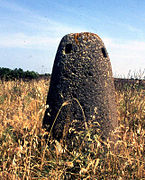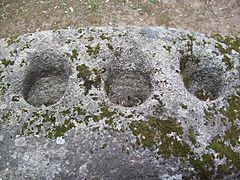Stone cult
Stone cults and stone worship ( Litholatrie ) have passed since the ancient widespread. It is possible that erect stones were already considered to represent deities in the Neolithic Age and were therefore cult stones. In this sense, some researchers also interpret the obelisks in ancient Egypt and the Baityloi of Sardinia and the Irish-Celtic Turoe stone , in Greece it is the Omphaloi .
The beginning
The worship of erect stones begins in Natufien . A small stone pillar in the alcove of a Jericho II house is not the only evidence of this. In Munhata, south of Lake Tiberias , which was explored in the 1960s by Jean Perrot (1920–2012), several plastered niches in which a stone were found in the north walls of the houses, the lowest horizons from the pre-ceramic Neolithic B, revealed niches was standing. Munhata had a complex that stretched over 300 square meters and was surrounded by a thick mud brick wall on stone foundations. A podium made of three large basalt slabs with wide drainage channels in the center, a paved basin 3 × 2 m in size and several hearths suggest that the complex dates from the 8th to 7th millennium BC. Was a sanctuary. In the enclosed oval complex of Rosh Zin, another Natufia settlement, a large raw stone pillar had been erected. In the filling around its base one found offerings, which were probably made on the occasion of the erection of the column.
Old testament
Moses received the order from YHWH to destroy the cult stones in Canaan. The worship of menhirs accompanies the stone cult into historical times. In the Old Testament the holy stone is called Mazewa . In contrast to the view of the Canaanites, who identified him with the deity, the Israelites reinterpreted him as a sign of God's presence or as a memorial to special events, as a "testimony stone". The Gilgal of the Bible, the circle of twelve stones, symbols of the twelve tribes of Israel, which Joshua supposedly had erected as a reminder of the crossing of the Jordan, was probably a complex from the era of the Palestinian megalithic culture. The story of Jacob's ladder tells that he slept on a stone and realized that "the Lord was in this place." He set up the stone, doused it with oil and called it "Bethel", which means "House of God". In spite of the prophets' opposition to stone worship, menhirs, rows, circles and squares made of erect elongated blocks in Israel and Jordan were remarkably often preserved in the area of megalithic necropolises. The monuments of Ain es Zerka in Jordan on a rock terrace with around 50 large stone graves are among the most impressive . On an elevation in the center of the plateau, three menhirs almost 2.0 m high rise up, which are enclosed by a small stone circle.
- Baityloi
Antiquity
In ancient times, different peoples in the Mediterranean revered stones. A stone cult is documented in the Canaanite religion as part of the Ba'al cult . In Greek these stones were called baitýlia or baítyloi , Latin baetuli ; it is the German word betyl derived (Additional possible in German literature, the names Bätylien , Bäthylien , Baitylien , Baethylien and Betyle before). The Greek name is derived from Aramaic bet el ("House of God", cf. Hebrew Bet-El ).
The word batyl is first attested in the 1st century by Pliny the Elder , who reports in his Naturalis historia of black, round stones that were considered sacred and whose (magical) help was used in the siege of cities and in naval warfare; her name is baetuli . The Phoenician scholar Herennios Philon (Philon von Byblos) who wrote in Greek also uses the term. He cites a (probably fictional) Phoenician scholar named Sanchuniathon who lived before the time of the Trojan War . According to Philon's account, there were “ ensouled ” stones ( baitýlia ), which Uranos produced and used in his fight against his son Kronos . As a representative of the religious interpretation of euhemerism , which regards the gods as mortals deified by man, Philo meant that Uranos and Kronos were originally mortals who were later made gods. According to Philo's version of the myth, the ensouled stones could evidently move on their own and thus hit the opponent Kronos.
Numerous coins from the Roman Empire , on which they are depicted, testify to the popularity of the batyle among the Phoenicians . Such coins come from the cities of Sidon , Byblos and Tire .
Some of the batyls were meteorites . They were either consecrated to the gods or were considered divine themselves. The origin of the meteorites "from the sky" was known. Among the Greek gods, Apollo was most closely associated with the stone cult. The name of the god Hermes (Greek ἕρμα herma : "rock", "stone", "ballast") indicates a connection with a stone cult.
For the Israelites the stone was significant at the Jacob slept, according to Gen 28:11 when he was in a dream vision of the Jacob's ladder saw. He anointed this stone the following morning and set it as a memorial stone. According to the biblical story, he called the place Bet-El .
Stone cult is also attested in the Minoan culture on Crete , where cult stones were regarded as residences of deities or spirits of the deceased. The Hittites also had holy stones that were in temples or sanctuaries and were anointed. In 2008, a stele of Kuttamuwa was discovered in Zincirli , Turkey, dating from the 8th century BC. And its inscription says that the soul of the Kuttamuwa depicted on it lived in the stone after his death.
Sardinia; Baityloi
A few meters from the giant grave of Tamuli in Sardinia are the approximately 1.5 meter high perdas marmuradas - six nuragic baityloi (Italian: Betili), three male and three female, which were known as "sa petra uue sunt sos thithiclos" (the stone with the breasts) and refer to the Sardinian stone cult. The stones, especially as a combination of three in many places in Sardinia, come u. a. at the giant grave of Perdu Pes near Paulilatino . The giant graves of the 2nd generation like Pradu Su Chiai but also some Domus de Janas (like Molafa ) have a tooth frieze (Italian: fregio a dentelli) with three recesses, which were used to accommodate small grenade-shaped baityloi.
Famous cult stones
- The black stone in the Kaaba in Mecca , which was venerated in pre-Islamic times.
- The black conical stone in Kouklia ( Cyprus ), which was venerated as Ishtar - Astarte and later as Aphrodite .
- The black, square, unhewn stone of the god Dusares , which the Nabataeans in Petra worshiped, placed on a gold base .
- The stone of Bet-El (north of Jerusalem), which the Canaanites worshiped as the residence of the god El . Bethel is the first book of Genesis ( Gen 28:19 EU mentioned) as a publication of the Jacob's ladder.
- The Benben stone in Heliopolis (Egypt)
- The stone of Zeus Casios in Seleukia Pieria (Syria).
- The stone of Emesa ( Homs in Syria), which was sacred to the god Elagabal . The cult of this god was introduced as a state cult in Rome in 219 by the Roman emperor Elagabal , and the stone was transferred there. After the murder of the emperor in 222 the stone was brought back to Emesa.
- The stone of the moon god Sin in Harran (Northern Syria, today Turkey).
- The black stone of the god mother Cybele of Pessinus in Phrygia , set in silver , which was made at the instigation of an oracle of the Sibyl in 205/204 BC. Brought to Rome and housed there in its own temple on the Palatine Hill.
- The Aigospotamoi meteor on the Chersonesus in Thrace .
- The stone Omphalos, which is sacred to the god Apollo and covered by wickerwork of wool, in the Sanctuary of Apollo at Delphi .
- The stone also set up in Delphi, which according to the myth the goddess Rhea gave to the god Kronos . Kronos devoured the stone believing it was his son Zeus . Zeus later forced Kronos to spit out the stone and set the stone up in Delphi.
- The stone of Zeus in the city of Gythio , the port of Sparta .
- The stone of Scone , which played an important role in the coronation of the Scottish monarchs and still plays in the coronation of the British monarchs today.
See also
literature
- Matthias Bärmann (Hrsg.): The book from the stone - texts from 5 millennia . Jung & Jung, Salzburg and Vienna 2005, ISBN 3-902497-02-5 , p. 7–58 (especially Chapters I – IV).
- Milette Gaifman: Aniconism and the Notion of the "Primitive" in Greek Antiquity . In: Joannis Mylonopoulos (Ed.): Divine Images and Human Imaginations in Ancient Greece and Rome . Brill, Leiden 2010, ISBN 978-90-04-17930-1 , pp. 63-86
- Manfred Hutter: cult steles and baityloi. The broadcast of a Syrian religious phenomenon to Asia Minor and Israel. In: Bernd Janowski, Klaus Koch / Gernot Wilhelm (eds.): Relationships in the history of religion between Asia Minor, Northern Syria and the Old Testament. International Symposium Hamburg (Orbis Biblicus et Orientalis, 129), Freiburg CH 1993, pp. 87-108.
- Uta Kron : Holy stones . In: Heide Froning (Ed.): Kotinos. Festschrift for Erika Simon . Von Zabern, Mainz 1992, ISBN 3-8053-1425-6 , p. 56-70 .
- Giovanni Lilliu , Hermanfrid Schubart : Early marginal cultures of the Mediterranean area. Corsica, Sardinia, Balearic Islands, Iberian Peninsula. Holle, Baden-Baden 1979, ISBN 3-87355-192-6
- Nanno Marinatos: Meta-mythology of "Baetyl Cult". The Mediterranean Hypothesis of Sir Arthur Evans and Fritz Graf . In: Ueli Dill , Christine Walde (Ed.): Ancient Myths. Media, transformations and constructions . De Gruyter, Berlin 2009, ISBN 978-3-11-020909-9 , pp. 406-414
- Karel van der Toorn: Worshiping Stones: On the Deification of Cult Symbols. In: Journal of Northwest Semitic Languages 23, 1997, pp. 1-14
- Emil Reisch : Ἀργοὶ λίθοι . In: Paulys Realencyclopadie der classischen Antiquity Science (RE). Volume II, 1, Stuttgart 1895, Col. 723-728.
Web links
- anthropomorphic baitylos by Viddalba in the Museo Sanna
- Images of Sardinian Betili
- Stones from San Lorenzo Sardinia
- The four Oragiana stones come from the giant grave of the same name. They are standing in the courtyard of the church of Santa Caterina d'Alessandria .
- Betili del tipo Oragiana video
Remarks
- ↑ Detlef W. Müller: Menhirs . In: Reallexikon der Germanischen Altertumskunde Vol. 19, 2001, p. 532 (with an illustration of an incised drawing of the "dolmen goddess" on a Neolithic menhir stele).
- ↑ a b Friedrich Münter (1805) About the stones of the ancients that fell from heaven, called Bäthylia ; Copenhagen and Leipzig, Johann Heinrich Schubothe
- ↑ Pliny, Naturalis historia 37, 51, 135.
- ↑ Herennios is quoted by Eusebius of Caesarea , Praeparatio evangelica 1.10.23; Greek text by Albert I. Baumgarten: The Phoenician History of Philo of Byblos. A Commentary , Leiden 1981, p. 16, English translation p. 182, commentary p. 202 f.
- ^ Albert I. Baumgarten: The Phoenician History of Philo of Byblos. A Commentary , Leiden 1981, p. 202
- ↑ Martin Persson Nilsson , History of the Greek Religion , Vol. 1, 3rd Edition, Munich 1967, p. 201.
- ^ Nilsson p. 204.
- ↑ Marinatos (2009) pp. 76-79.
- ↑ Report with illustration .
- ↑ http://www.neroargento.com/page_galle/pradu_gallery.htm picture of a tooth frieze





